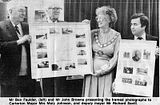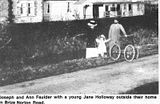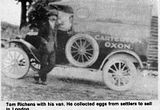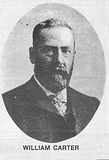Carterton was a hamlet of 200 or so people when Ben Faulder was born there in 1911. His home in Brize Norton Road was one of less than 50 which had been built since the settlement was started by William Carter in 1900. There was no village school, no electricity, and the settlers had to draw their water from wells they had sunk on their smallholdings. Most of the early settlers were farmers like Mr Faulder's father, Joseph. They had been lured to the area by the prospect of buying their own smallholdings. In 1894 the Duke of Marlborough sold -Rock Farm, a 740-acre spread in the Parish of Black Bourton, to Mr Thomas Arkell for £5,450. The farmhouse was close to what is now the town centre crossroad — Mr Faulder's cousin, Jack, still lives at Rock Farm. Mr Carter's firm, Homesteads, bought the farm in 1900 and divided it into smallholdings, which were then sold to the settlers. Mr Faulder lived in Carterton until 1947. He didn't follow his father onto the land, but trained as a carpenter and builder. In 1936 he helped build the officer's mess at the new aerodrome at Brize Norton. The expansion of the airfield, which started as a pilot training base, has been largely responsible for the mushrooming of Carterton from hamlet to a fast-expanding town, which currently has just over 13,000 people. Mr Faulder went to what was then South-ern Rhodesia in 1947 where he created a successful building business. But in 1984 he returned from Zimbabwe to Oxfordshire. He now lives in Honeyham Close, Brize Norton with his wife, Fay. One of his boyhood friends, Mr John Browne, 79, of Black Bourton Road, Carterton, a retired motor engineer, has always taken a keen interest in the history of Carterton. Mr Browne gives talks on the subject to local schools. He has used a collection of photos built up by Mr Faulder's sister, Mrs Jane Holloway, of the old Carterton to help illustrate talks and for exhibitions. But Mrs Holloway lives in Potterne near Devises, Wiltshire, and Mr Browne thought it would be useful if the photographs were permanently kept in Carterton. He persuaded Mrs Holloway to let the town council have them, and Mr Faulder used his cabinet making skills to create two frames to house them. The framed collection of photographs has just been handed over to town mayor Mrs Mary Johnson, and deputy mayor Mr Richard Savill. They have been put on display in the town hall in Alvescot Road. Mrs Johnson said: "We are very proud to have been chosen by Mr Faulder and his sister to receive the photographs and look after them. "We can go back into Carterton's history reasonably easily because it has not beengoing for very tong. VVee are gradually building up our archives. "These photographs will be of interest to everyone in Carterton, from the very young to the very old, who want to know about the roots of the town." And Mr Browne has also organised another contribution to the recording of Carterton's history. His direct knowledge of the place goes back no further than 1917, the year he came to Carterton with his mother and sister to escape the Zeppelin raids on London. He realised that Mr Faulder had a very good knowledge of the town's earlier days so suggested to him that he write something about the subject. Mr Faulder worked for about three months assembling material for a pamphlet, checking dates and other information with his sister and cousin to make sure they were as accurate as possible. He even compiled a map of the properties owned by the early settlers. The result is Recollections of Early Carterton, which Mr Faulder has just had privately published, and is on sale in various shops in the town, price £2. Mr Faulder still has many vivid memories of the old Carterton. He recalls the time when the only traffic on the streets was horse drawn. And he can remember the stir it created when the Akers family from Black Bourton drove their Renault car through Carterton. Dairy farmer Mr Faulder recollects seeing a plough being pulled backwards and forwards across a field on a wire slung between two stationary traction engines as he walked to school in Brize Norton. His father, Joseph, was one of the town's founding fathers and some of his activities are recalled in the pamphlet. He moved to Carterton with his wife, Anne, in 1902 from Surrey, bought land in Brize Norton Road and started a dairy farm. He was one of the new settlement's milk-men. He gradually extended his landholdings, buying the meadow at the junction of Alvescot and Corbett Road, and moving there in 1920. Joseph Faulder took a keen interest in the affairs of the parish and was elected to the parish committee in 1905. In those days Carterton was so small it didn't even merit its own parish committee, and was the responsibility of the Black Bourton Parish Committee. Joseph Faulder served on the parish corn- - mittee and its successor councils for 37 years, becoming, among other things: trustee of the recreation ground, chairman of the Carterton Co-operative Society, Warden of St John's Church, trustee of the tennis and bowls club, and treasurer of the Carterton Horticultural Society. His memory and that of his brother, John, lives on in the town today for one of its streets is named Faulder Avenue. DONALD COLE
|
Click on any of the images below for a larger version |
|





